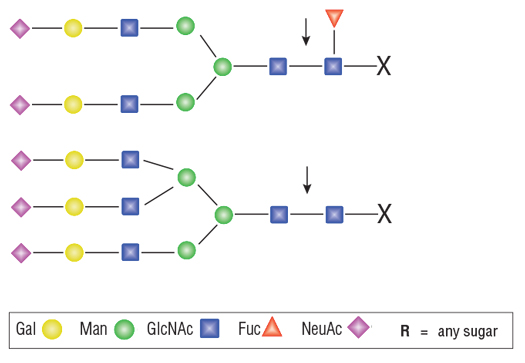上海金畔生物科技有限公司代理New England Biolabs(NEB)酶试剂全线产品,欢迎访问官网了解更多产品信息和订购。
产品信息
Specificity

产品来源
Cloned from Elizabethkingia miricola (formerly Flavobacterium meningosepticum) and expressed in E. coli.
- 产品类别:
- Endoglycosidases Products,
- Proteome Analysis Products
- 应用:
- Expression Systems,
- Glycan Sequencing,
- Proteomics,
- Recombinant Glycoprotein Expression,
Glycoprotein Analysis
-
产品组分信息
本产品提供以下试剂或组分:
NEB # 名称 组分货号 储存温度 数量 浓度 -
P0771S -20 Endo F3 P0771SVIAL -20 1 x 0.03 ml 8,000 units/ml GlycoBuffer 4 B1703SVIAL -20 1 x 1 ml 10 X
-
-
特性和用法
单位定义
One unit is defined as the amount of enzyme required to cleave > 95% of the carbohydrate from 10 µg Porcine Fibrinogen in 1 hour at 37°C in a total reaction volume of 10 µl.
反应条件
1X GlycoBuffer 4
Incubate at 37°CGlycoBuffer 4
50 mM sodium acetate
(pH 4.5 @ 25°C)贮存溶液
20 mM Tris-HCl
50 mM NaCl
5 mM EDTA
pH 7.5 @ 25°C热失活
65°C for 10 minutes
分子量
实际: 38.8 kDa
单位活性检测条件
Two fold dilutions of Endo F3 are incubated with 10 µg Porcine Fibrinogen and 1X GlycoBuffer 4 in a 10 µl reaction. The reaction mix is incubated at 37°C for 1 hour. Separation of reaction products are visualized via SDS-PAGE.
-
相关产品
相关产品
- p0702-endo-h
- p0703-endo-hf
- p0709-pngase-f-glycerol-free-recombinant
- Rapid 快速 PNGase F
- p0711-rapid-pngase-f-non-reducing-format
- Endo S
- 糖苷内切酶 D
-
注意事项
- The optimal pH for the cleavage of fucosylated-biantennary (i.e. porcine fibrinogen) and triantennary glycans (i.e. fetuin) is pH 4.5 (10X GlycoBuffer 4). However, fucosylated-biantennary glycans can also be cleaved at pH 6.0 (10X GlycoBuffer 3).
- The enzyme should be used under non-denaturing conditions. Detergents, such as SDS, inhibit Endo F3 activity.
- Reactions may be scaled-up linearly to accommodate larger reaction volumes.
操作说明、说明书 & 用法
-
操作说明
- Typical Reaction Conditions for Endo F3 Protocol (P0771)
工具 & 资源
-
选择指南
- Endoglycosidase Selection Chart
FAQs & 问题解决指南
-
FAQs
- Is Endo F3 tagged?
- What is the difference between PNGase F and Endo F3?
- How much Endo F3 should I use to deglycosylate a glycoprotein under native conditions?
- What is the preferred substrate for Endo F3?
- Do detergents inhibit Endo F3 activity?
- What is the optimal pH for Endo F3 activity?
- How do I eliminate Endo F3 from a reaction?
- What is the binding capacity of the Magnetic Chitin Beads used to remove Endo F3?
- Is Endo F3 compatible with downstream analysis such as HPLC and Mass Spectrometry?
- What are Glycosidases and their uses?
-
实验技巧
- Endo F3 is tagged with a chitin binding domain (CBD) for easy removal from a reaction using chitin magnetic beads (NEB #E8036)
- Endo F3 should be used under non-denaturing conditions. Detergents, such as SDS, inhibit Endo F3 activity.
- The optimal pH for the cleavage of triantennary glycans (i.e. fetuin) is pH 4.5 (10X Glycobuffer 4).
- Fucosylated-biantennary glycans (i.e. porcine fibrinogen) can be cleaved at both pH 4.5 (10X Glycobuffer 4) and at pH 6.0 (10X Glycobuffer 3).
